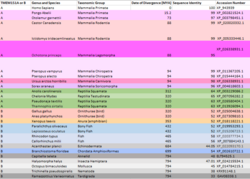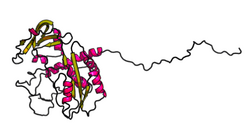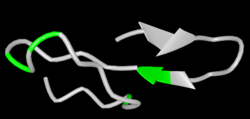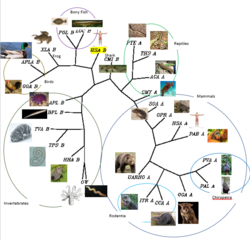Biology:Transmembrane protein 151A
Transmembrane protein 151A, also known as TMEM151A, is a protein that is encoded by the TMEM151A gene.[1]
Gene
The gene encoding transmembrane protein 151A is located on the positive strand of chromosome 11q13.2 and has two exons.[1][2] The gene consists of a total of 2538 nucleotides, 1407 of which encode for the amino acids of the final transcript.[2]
Protein
Transmembrane protein 151A has 468 amino acids, weighs 51,278 daltons, and is an integral component of cellular membranes.[1] Transmembrane protein 151A has three transmembrane domains. The N-terminus of the protein is located in the cytosol and the C-terminus is located in the extracellular matrix. According to Compute pI, this protein has a molecular weight of approximately 51 kDa,[3] which is the same molecular weight provided by NCBI protein.[4] Sigma-Aldrich demonstrates that TMEM151A has a molecular weight of approximately 55 kDa[5] which suggests that the protein may undergo post-translational modifications. The theoretical pI of the whole protein is approximately 8. Exon 1 is smaller and more acidic than exon 2. Transmembrane domain 2 is acidic, although it is located in exon 2 which averages to be basic. TMEM151A has no known isoforms,[6] and is a part of family pfam15857 with one paralogue: TMEM151B.[7]
The secondary structure of the protein is predicted to consist of approximately alpha helices and beta sheets (the exact location and number of which depend on the program which is used for the prediction) but no coiled coils.[8][9][10] Diagrams of the predicted tertiary structure and transmembrane domains[11] are to the right.
Protein compositional analysis
The most abundant amino acids in TMEM151A are alanine and leucine. The least abundant are lysine, methionine, and asparagine. There is less asparagine, isoleucine, and lysine than would be expected for an average protein. The internal compositional analysis of all the individual segments of the protein (ex. transmembrane domain 1, intermembrane space, n-terminus, etc.) all had amino acid abundances that fell into expected ranges except for the c-terminus. Specifically, there is less asparagine, isoleucine, and lysine and more arginine than would be expected for an average protein in the c-terminus. TMEM151A composition is highly conserved between mammals.[12]
Protein level regulation
TMEM151A in Homo sapiens and other vertebrates (grizzly bears, chickens, and lancelets) have N-myristoylation sites in the N-terminus whereas non vertebrates (capitella teleta and water bear) instead have more phosphorylation sites instead (and one n-myrstyolation site) in the N-terminus.[13] TMEM151A in humans has 3 glycation sites, it may have a nuclear export signal, 2 palmoylation sites, many phosphorylation sites, 1 signal peptide, 1 arginine and lysine cleavage site, and multiple O-BetaGlcNac sites.[14][15][16][17][18][19][20][21][22] The table below lists predicted post translational modifications for TMEM151A in several species.
| Number of modifications | Human | Ursus arctos horribilis | Gallus gallus | Branchiostoma floridae | Capitella teleta | Ramazzottius varieornatus |
| Palmoylation sites[23] | 2 | 2 | 0 | 1 | 2 | 2 |
| Transmembrane regions[24] | 3 | 3 | 3 | 3 | 3 | 3 |
| Phosphorylation sites* | 743 | 765 | 999 | 574 | 538 | 1076 |
| Sumo-interaction[25] | 1 | 1 | 1 | 0 | 0 | 4 |
| Net glycation **[26] | 3 | 3 | N/A | N/A | N/A | N/A |
| Nuclear export signals | 3 | 3 | 2 | 0 | 8 | 4 |
| Phosphorylation sites[27] | 92 | 91 | 129 | 70 | 54 | 102 |
| Another prediction of transmembrane regions[28] | 3 | 3 | 3 | 3 | 3 | 3 |
| Prediction of arginine and lysine cleavage sites | 1 | 1 | 0 | 0 | 0 | 0 |
| Signal peptide prediction[29] | 1 | 1 | 0 | 1 | 1 | 0 |
| Sulfinated tyrosines[30] | 2 | 2 | 1 | 1 | 0 | 1 |
| TMHMM transmembrane regions[31] | 3 | 3 | 3 | 3 | 3 | 3 |
| O-beta glcnac attachment sites | multiple | multiple | multiple | multiple | multiple | multiple |
Cellular localization
TMEM151A protein is predicted to localize in the endoplasmic reticulum for Homo sapiens, mammals, lancelets, and some invertebrates. It is predicted to localize in the nucleus for birds and other invertebrates (Table 1).[32]
| Humans | Ursus arctos horribilis | Gallus gallus | Branchiostoma floridae | Capitella teleta | Ramazzottius varieornatus | |
| Endoplasmic reticulum | 55.6 | 39.1 | 4.3 | 55.6 | 66.7 | 13 |
| Mitochondria | 22.2 | 30.4 | 17.4 | 11.1 | 0 | 8.7 |
| Secretory system vesicles | 11.1 | 0 | 4.3 | 0 | 4.3 | |
| Plasma membrane | 11.1 | 13 | 8.7 | 22.2 | 0 | 34.8 |
| Nuclear | 0 | 8.7 | 52.2 | 0 | 0 | 17.4 |
| Cytoplasmic | 0 | 8.7 | 8.7 | 0 | 0 | 4.3 |
| Extracellular | 0 | 0 | 4.3 | 0 | 11.1 | 8.7 |
| Vacuolar | 0 | 0 | 0 | 11.1 | 11.1 | 0 |
| Golgi | 0 | 0 | 0 | 0 | 11.1 | 0 |
Table 1: Predicted localization of TMEM151 in various species
Gene level regulation
The TMEM151A promoter region consists of 1101 base pairs and it is directly adjacent to the base pairs which code for the first amino acid of the TMEM151A protein.[33] Thousands of transcription factors were predicted to bind on this promoter region. Of those, 20 transcription factors are listed in the table below. Many transcription factors predicted to bind to the promoter region were related to the following categories:
- Neural and growth related
- Huntington's
- KRAB/Zinc finger
- Steroid (androgen/estrogen)
| # | Transcription factor description | Matrix similarity |
| 1 | cAMP-responsive binding element | 1 |
| 2 | KRAB containing zinc finger protein | 1 |
| 3 | Huntington's disease gene regulatory region binding proteins (more downstream | 0.859 |
| 4 | Huntington's disease gene regulatory region binding proteins (more upstream) | 0.888 |
| 5 | EGR1, early growth response 1 | 0.906 |
| 6 | GA binding protein transcription factor, alpha
(likely involved in nuclear control of mitochondrial function and cytochrome oxidase expression) |
0.935 |
| 7 | ZF5 POZ domain zinc finger protein | 0.836 |
| 8 | ZF1-myeloid zinc finger 1 protein | 0.992 |
| 9 | Nerve growth factor induced protein C | 0.803 |
| 10 | Estrogen Receptor 2 | 0.914 |
| 11 | GATA-GATA binding factor 1 | 0.989 |
| 12 | Pleomorphic adenoma gene 1 (salivary gland tumor) | 1 |
| 13 | Glial cells (nerve support) missing homolog 1 | 0.953 |
| 14 | Androgene receptor binding site | 0.935 |
| 15 | EGR/nerve growth factor induced protein C & related factors | 0.902 |
| 16 | KRAB domain zinc finger protein 57 | 0.942 |
| 17 | Estrogen related receptors | 0.924 |
| 18 | Huntington's disease gene regulatory region binding proteins (most upstream) | 0.850 |
| 19 | Leucine rich repeat (in FLII) interacting protein 1 | 0.865 |
| 20 | Krueppel-associated box-containing zinc-finger protein 57 (KRAB-ZFP 57) | 0.960 |
Five different promoters influence the expression of this gene.[2]
TMEM151A expression in humans
Immunohistochemistry demonstrates that TMEM151A RNA is primarily expressed in the brain (specifically the hippocampus, caudate, cerebellum, and pituitary gland), and has low levels of expression in the stomach, adipose tissue, retina, gallbladder, testes, colon, heart muscle, pancreas, salivary gland; a polyclonal rabbit TMEM151A antibody from Sigma Aldrich was used to get these results. These results were listed as “uncertain.”[34]
Unigene microarray analysis shows that Homo sapiens TMEM151a DNA is found at relatively higher levels in the heart and the brain (specifically the frontal and occipital cortexes), and has lower levels of expression in multiple other tissues.[35]
TMEM151A expression in other animals
Microarray analysis demonstrates that Mus musculus TMEM151a DNA has increased levels of expression in the heart, and has lower levels of expressions in multiple other tissues.[36] Results from the Allen Brain Atlas demonstrate that the mouse isocortex has increased levels of in situ hybridization with TMEM151A.[37] Microarray analysis of Canis lupus familiaris shows that TMEM151a DNA increased in both the cerebrum and the pancreas.[38]
Homology and evolution
Transmembrane protein 151A has one paralogue: TMEM151B which has a 50.76% identity with TMEM151A. It is hypothesized that TMEM151A first arose as a gene duplicate of TMEM151B approximately 320 Million Years Ago in reptiles. TMEM151A is evolving at approximately the same rate as Hemoglobin B.[39][40]
It appears as though TMEM151 is conserved in most if not all vertebrates, and is conserved in many invertebrates (except for Porifera and Cnidaria). The details of this conclusion are listed below:
TMEM151A and TMEM151B are conserved in all of the major mammal orders: Primates, Rodentia, Lagomorpha, Chiropetra, Artiodactyla, Carnivora, Soricomorpha, and Diprotodontia. TMEM151A and TMEM151B were present in the following reptile orders: Squamata and Testudinata. TMEM151B (only) was found in many extant bird orders including: Columbiformes, Caprimulgiformes, Apodiformes, and Cuculiformes. TMEM151A was not present in any bird species. This suggests that TMEM151A evolved via gene duplication approximately 320 million years ago, as reptiles do have both TMEM151A and TMEM151B, but birds only have TMEM151A.
TMEM151B is present in the amphibian order Anura. TMEM151B could not be found in the amphibian order Caudata (newts and salamanders) or Apoda (caecilians) in either BLAST or BLAT (bioinformatics). This absence in amphibians may be due to (1) a lack of records or (2) genetic divergence. TMEM151B is present in several bony fish orders including: perciformes, tetraodontiformes, and siluriformes. It could not be found in the bony fish order lophiiformes. TMEM151B is present in cartilaginous fishes, specifically sharks. TMEM151B was not found for lampreys or rays in BLAST; however, TMEM151B was found in BLAT for lampreys. This suggests that TMEM151B is likely found in many cartilaginous fishes; it is simply not recorded. TMEM151B could not be found in jawless fish in either BLAST or BLAT.

TMEM151B could not be found in tunicates, but it was found in one lancelet. As TMEM151B was found in lancelets, TMEM151B is found in Echinodermata, but not found in Porifera, nor Cnidaria. TMEM151B is also found in Annelida, Mollusca, Nematoda, Tardigrada, and Arthropoda.[41]
Protein interactions
According to STRING, TMEM151A is predicted to interact with the following proteins:[42][2]
- TMEM71 – May localize in the mitochondrion or plasma membrane. It is primarily expressed in the circulatory (blood, lymph node, cardiac cells) and nervous system (brain, cortex, cerebellum, spinal cord, tibial nerve).
- TMEM179-is located on chromosome 14, and or 90. It is predicted to localize in the mitochondria membrane
- C9orf64 – this encodes the queosine salvage protein (the function of which is not well understood). Expression of this gene is highest in the duodenum and small intestine, it is a member of the DUF 2419 family.
- C1orf167 – is a protein encoding gene of unknown function. It is associated with neural tube defects and folate sensitivity.
- ZSCAN32 – is a human cervical cancer suppressor gene. It has RNA polymerase II specific activity
- SAMD10 – stands for sterile alpha motif domain containing protein 10. It is located on chromosome 20. Diseases associated with this gene include retinitis pigmentosa. It is predicted to localize in the nucleus/nucleoplasm.
- ANKDD1A – is located on chromosome 15 and is predicted to localize in the peroxisome and/or cytosol.
- SOWAHD – Sosondowah Ankyrin repeat domain family member D. It is located on chromosome X and predicted to localize in the mitochondrion.
- CCDC135 – is associated with diseases: Meckel syndrome, type 6 and type 1. It is located on chromosome 16 and is predicted to localize in the nucleus, cytosol, and most likely in the cytoskeleton.
- TMEM88 – is located on chromosome 17 and is crucial for heart development and aids in the specification of lineage commitment of cardiomyocyte development
Research in humans
Illumina analysis has demonstrated that TMEM151A is one of 336 genes that may be used, in combination with the other genes, to diagnose colorectal cancer and/or the stage of that cancer. Specifically, TMEM151A is significantly upregulated in human monocytes circulating in the blood during colorectal cancer.[43] TMEM151A is in linkage disequilibrium with gene CACNA1C; CACNA1C mutation is significantly associated with bipolar disorder p < 0.05.[44] An unspecified variant of TMEM151A is one of 27 genes (out of 47,296 rare exonic variants that were analyzed) that has been associated with major depression disorder in Mexican Americans. These Mexican Americans experienced hyperactivation of the hypothalamic-pituitary-adrenal axis due to significant stress.[45] Transplanted livers that came from deceased donors had a 4.83-fold upregulated expression of TMEM151A when compared to the expression levels of TMEM151A in livers that came from live donors.[46]
References
- ↑ 1.0 1.1 1.2 "transmembrane protein 151A [Homo sapiens – Protein – NCBI"]. https://www.ncbi.nlm.nih.gov/protein/23397566. Retrieved 27 April 2019.
- ↑ 2.0 2.1 2.2 2.3 "Gene Cards TMEM151A". https://www.genecards.org/cgi-bin/carddisp.pl?gene=TMEM151A.
- ↑ "Compute PI/Molecular Weight". https://web.expasy.org/cgi-bin/compute_pi/pi_tool.[yes|permanent dead link|dead link}}]
- ↑ "Tissue expression of TMEM151A – Summary – The Human Protein Atlas". https://www.proteinatlas.org/ENSG00000179292-TMEM151A/tissue.
- ↑ "Anti-TMEM151A antibody produced in rabbit HPA041035". https://www.sigmaaldrich.com/catalog/product/sigma/hpa041035.
- ↑ "TMEM151A transmembrane protein 151A [Homo sapiens (human) – Gene – NCBI"]. https://www.ncbi.nlm.nih.gov/gene/256472. Retrieved 27 April 2019.
- ↑ "Gene: TMEM151A (ENSG00000179292) – Summary – Homo sapiens – Ensembl genome browser 96". https://uswest.ensembl.org/Homo_sapiens/Gene/Summary?g=ENSG00000179292;r=11:66291870-66296664;t=ENST00000327259. Retrieved 27 April 2019.
- ↑ "JPRED". http://www.compbio.dundee.ac.uk/jpred4/cgi-bin/chklog?keywords=jp_A9dhann.
- ↑ "NPS@ : GOR4 secondary structure prediction". https://npsa-prabi.ibcp.fr/cgi-bin/secpred_gor4.pl. [full citation needed]
- ↑ "I-TASSER results". https://zhanglab.ccmb.med.umich.edu/I-TASSER/output/S461070/.
- ↑ "Helical Wheel Rutgers". http://www-nmr.cabm.rutgers.edu/bioinformatics/Proteomic_tools/Helical_wheel/.
- ↑ "SAPS". https://www.ebi.ac.uk/Tools/services/web/toolresult.ebi?jobId=saps-I20190402-143348-0458-14879099-p2m.
- ↑ "N-Myristylation Sites ExPasy". https://web.expasy.org/myristoylator/TMEM151A.
- ↑ "CSS-Palm – Palmitoylation Site Prediction". http://csspalm.biocuckoo.org/showResult.php.
- ↑ "DAS-TMfilter server". http://mendel.imp.ac.at/sat/DAS/DAS.html.
- ↑ "GPS-SUMO: Prediction of SUMOylation Sites & SUMO-interaction Motifs". http://sumosp.biocuckoo.org/online.php.
- ↑ "NetGlycate 1.0 Server" (in en). http://www.cbs.dtu.dk/services/NetGlycate/.
- ↑ "5CBA9F710000143B6B879311 expired". http://www.cbs.dtu.dk/cgi-bin/webface2.fcgi?jobid=5CBA9F710000143B6B879311&wait=20.
- ↑ "Phobius". http://phobius.sbc.su.se/.
- ↑ "ProP". http://www.cbs.dtu.dk/cgi-bin/webface2.fcgi?jobid=5CBAB33C00002F5C22ED82DB&wait=20.
- ↑ "ExPASy – Sulfinator tool". https://web.expasy.org/sulfinator/.
- ↑ "TMHMM". http://www.cbs.dtu.dk/cgi-bin/webface2.fcgi?jobid=5CBABD7D0000393B3A8B36C4&wait=20.
- ↑ "CSS-Palm – Palmitoylation Site Prediction". http://csspalm.biocuckoo.org/showResult.php. Retrieved 27 April 2019.
- ↑ "DAS-TMfilter server". http://mendel.imp.ac.at/sat/DAS/DAS.html. Retrieved 27 April 2019.
- ↑ "GPS-SUMO: Prediction of SUMOylation Sites & SUMO-interaction Motifs". http://sumosp.biocuckoo.org/online.php. Retrieved 27 April 2019.
- ↑ "NetGlycate 1.0 Server". http://www.cbs.dtu.dk/services/NetGlycate/. Retrieved 27 April 2019.
- ↑ "5CBA9F710000143B6B879311 expired". http://www.cbs.dtu.dk/cgi-bin/webface2.fcgi?jobid=5CBA9F710000143B6B879311&wait=20. Retrieved 27 April 2019.
- ↑ "Phobius". http://phobius.sbc.su.se/. Retrieved 27 April 2019.
- ↑ "5CBAB33C00002F5C22ED82DB expired". http://www.cbs.dtu.dk/cgi-bin/webface2.fcgi?jobid=5CBAB33C00002F5C22ED82DB&wait=20. Retrieved 27 April 2019.
- ↑ "ExPASy – Sulfinator tool". https://web.expasy.org/sulfinator/. Retrieved 27 April 2019.
- ↑ "5CBABD7D0000393B3A8B36C4 expired". http://www.cbs.dtu.dk/cgi-bin/webface2.fcgi?jobid=5CBABD7D0000393B3A8B36C4&wait=20. Retrieved 27 April 2019.
- ↑ "PSORT II". https://psort.hgc.jp/cgi-bin/runpsort.pl.[yes|permanent dead link|dead link}}]
- ↑ "TMEM151A Genomatrix". https://www.genomatix.de/cgi-bin/eldorado/eldorado.pl?s=9c05c14674cedca3501a0e777c6e63bc.
- ↑ "TMEM151A Human Protein Atlas". https://www.proteinatlas.org/.
- ↑ "NCBI Unigene Transmembrane Protein151A". https://www.ncbi.nlm.nih.gov/geo/tools/profileGraph.cgi?ID=GDS1085:43043.
- ↑ "TMEM151A GDS3052 GEO". https://www.ncbi.nlm.nih.gov/geo/tools/profileGraph.cgi?ID=GDS3052:1433802_at.
- ↑ "TMEM151A Allen Mouse Brain Atlas". http://mouse.brain-map.org/experiment/thumbnails/100042147?image_type=atlas.
- ↑ "TMEM151A GDS4164 NCBI NIH". https://www.ncbi.nlm.nih.gov/geo/tools/profileGraph.cgi?ID=GDS4164:CfaAffx.19823.1.S1_at.
- ↑ "TimeTree". http://www.timetree.org/.
- ↑ "NCBI Blast". https://blast.ncbi.nlm.nih.gov/Blast.
- ↑ BLAST. ISBN 978-1-4493-5811-2. OCLC 326794237. https://blast.ncbi.nlm.nih.gov/Blast.cgi. Retrieved 2019-04-21.
- ↑ "STRING: functional protein association networks". https://string-db.org/.
- ↑ Mazzone. "Monocyte Cancer Biomarker 2013". http://patft.uspto.gov/netacgi/nph-Parser?Sect1=PTO2&Sect2=HITOFF&p=1&u=%2Fnetahtml%2FPTO%2Fsearch-bool.html&r=1&f=G&l=50&co1=AND&d=PTXT&s1=tmem151&OS=tmem151&RS=tmem151.
- ↑ Sklar, P.; Ripke, S.; Scott, L. J.; Andreassen, O. A.; Cichon, S.; Craddock, N.; Edenberg, H. J.; Nurnberger, J. I. et al. (September 2012). "Erratum: Large-scale genome-wide association analysis of bipolar disorder identifies a new susceptibility locus near ODZ4". Nature Genetics 44 (9): 977–983. doi:10.1038/ng0912-1072a. ISSN 1061-4036. PMID 21926972.
- ↑ Wong, M-L; Arcos-Burgos, M; Liu, S; Vélez, J I; Yu, C; Baune, B T; Jawahar, M C; Arolt, V et al. (2016-10-25). "The PHF21B gene is associated with major depression and modulates the stress response". Molecular Psychiatry 22 (7): 1015–1025. doi:10.1038/mp.2016.174. ISSN 1359-4184. PMID 27777418.
- ↑ Conti, Anna (2011-02-10). "Gene Expression Profile in Liver Transplantation and the Influence of Gene Dysregulation Occurring in Deceased Donor Grafts". The Open Surgery Journal 5 (1): 1–11. doi:10.2174/1874300501105010001. ISSN 1874-3005.
 |












